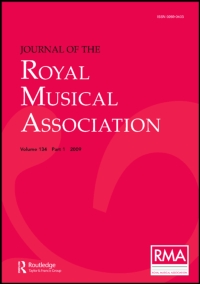Article contents
Temperament; or, the Division of the Octave
Published online by Cambridge University Press: 01 January 2020
Extract
The investigations which form the subject of the present communication had their origin in a practical source. It is conceived important that this should be understood, as many musicians regard the problem as a purely theoretical one, undeserving of practical attention. It was in taking part in the tuning of an organ that the effect of the ordinary equal temperament was first realised by the writer as a matter affecting musical sounds in practice, as distinguished from theory. It is the writer's experience that after the ear has once been attracted to this effect, it never fails to perceive it in the tones of instruments tuned in the ordinary way. Some tones show the effect more, some show it less. Among keyed instruments the worst effects are produced by the ordinary harmonium; next to this comes the full-toned modern grand piano, which is often unpleasant in slow harmony, especially if, as is generally the case, the temperament is not very uniform;∗ and the best tones, which show the effect least, are those of soft-toned pianos with little power, and the ordinary organ diapason-stops—especially those old-fashioned, sweet-toned diapasons, which are rapidly disappearing before the organ-builders of the present day. The constant perception of these effects served as an inducement to a study of the subject, pursued in the first instance with the practical object of the improvement of instruments, and afterwards also for the sake of the interest attaching to the theory developed.
- Type
- Research Article
- Information
- Copyright
- Copyright © Royal Musical Association, 1874
References
∗ The chord of E major is constantly found ‘rank’ on these pianos. This would suggest some defect in the process of tuning ordinarily used.Google Scholar
∗ See, however, Mr. A. J. Ellis on the ‘Temperament of Musical Instruments with Fixed Tones.’—Royal Society's Proceedings, 1864.Google Scholar
∗ These expressions were suggested to the writer by Mr. Parratt.Google Scholar
∗ See note at p. 121, post.Google Scholar
- 1
- Cited by


